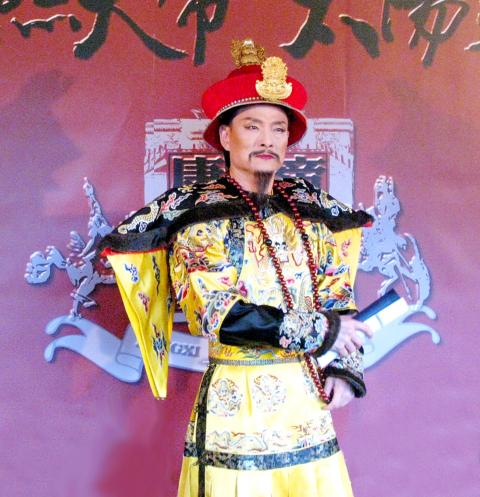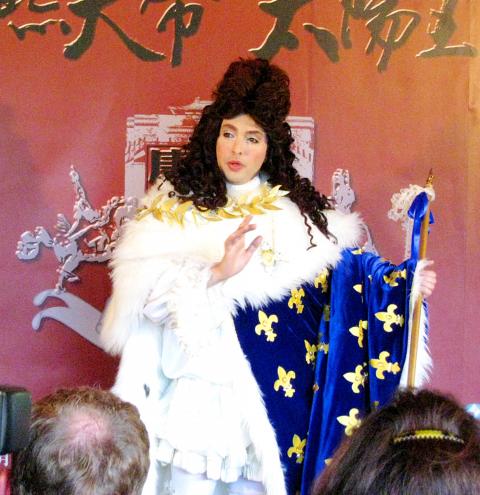The National Palace Museum under Chou Kung-shin (周功鑫) has sought to extend itself in a variety of new directions. Its New Melody series launched in July 2009 saw the linking of visual arts with performance arts, and has proved remarkably successful. With the announcement earlier this week that a completely new opera will be commissioned for the series, the museum is taking this idea a step further.
The opera, titled Kangxi Emperor and Louis-Dieudonne (康熙大帝與太陽王路易十 四), the production of which has been entrusted to Contemporary Legend Theatre (當代傳奇劇場), will be performed in conjunction with an exhibition of the same name that will run from Oct. 3 until Jan. 1 next year.
At a press conference held to announce this new and innovative collaboration, Chou said that the New Melody series’ linking of visual and performance arts had been a huge success.

Photo Courtesy of Contemporary Legend Theatre
“Since I took up my position in 2008, I have aimed to make the National Palace Museum a place with which everyone is familiar,” she said. “Of course, there has been criticism, with people saying it has become like a vegetable market or department store. If people come in any numbers, of course there is going to be noise. But if people come, they will learn, and if they come often, their appreciation of art will increase, and this will change their lives. With the New Melody series, what we wanted to do is provide a multifaceted introduction to art, one in which these works would leave a lasting impression. It is based on our experience of [the series] that we have taken on this new challenge, for we believe that the combination of visual and performance arts is a powerful one.”
The opera will be performed in the plaza outside the National Palace Museum on Oct. 15 and Oct. 16. Three additional performances will be held at the Miaoli Arena (苗栗小巨蛋) from Oct. 21 to Oct. 23.
Although the production is still a work in progress, the casting has begun. Contemporary Legend founder Wu Hsing-kuo (吳興國) will play the role of the Kangxi Emperor (康熙), while the court of Louis XIV will include tenor Jean Francois Novelli (as Louis), soprano Camille Poul and baritone Pierrick Boisseau. The libretto will be written by novelist Chang Ta-chun (張大春), who collaborated with Contemporary Legend on its pop-opera fusion trilogy 108 Heroes (水滸108), and the costumes will be created by Oscar-winning designer Tim Yip (葉錦添), who made the costumes for Ang Lee’s (李安) Crouching Tiger, Hidden Dragon (臥虎藏龍). The set and lighting design will be by Lin Keh-hua (林克華), who has been associated with many of Taiwan’s most successful international theatrical projects, most notably the sets for Cloud Gate Dance Theatre (雲門舞集). Conductor Paul Chiang (江靖波), the founder of Philharmonia Moments Musicaux (樂興之時管弦樂團), will be entrusted with managing the difficult combination of baroque music and kun opera (崑曲).

Photo Courtesy of Contemporary Legend Theatre
The essential point of both the exhibition and the opera is to show the cultural heights achieved under two powerful rulers who held sway over their respective domains at roughly the same time, and also to highlight the interaction that took place between the European and Chinese cultures during that period, often through the medium of Jesuit missionaries. Wu announced an ambitious design that employ tiered outdoor stage so that life at the early Qing Dynasty court could be juxtaposed with the different but equally sumptuous court of Louis XIV.
This is not the first time that high culture musical fusions between Taiwan and France have been attempted. This kind of project can be traced back to Han Tang Yuefu’s (漢唐樂府) Le Jardin des Delices (梨園幽夢) in 1999, if not earlier, and there have been many attempts at various forms of fusion since then. With a cast of 45, and an orchestra of 45 musicians from very different traditions, the talent and ambition behind this project augurs a memorable show that encapsulates the National Palace Museum’s broad new ambitions.

Every now and then, it’s nice to just point somewhere on a map and head out with no plan. In Taiwan, where convenience reigns, food options are plentiful and people are generally friendly and helpful, this type of trip is that much easier to pull off. One day last November, a spur-of-the-moment day hike in the hills of Chiayi County turned into a surprisingly memorable experience that impressed on me once again how fortunate we all are to call this island home. The scenery I walked through that day — a mix of forest and farms reaching up into the clouds

With one week left until election day, the drama is high in the race for the Chinese Nationalist Party (KMT) chair. The race is still potentially wide open between the three frontrunners. The most accurate poll is done by Apollo Survey & Research Co (艾普羅民調公司), which was conducted a week and a half ago with two-thirds of the respondents party members, who are the only ones eligible to vote. For details on the candidates, check the Oct. 4 edition of this column, “A look at the KMT chair candidates” on page 12. The popular frontrunner was 56-year-old Cheng Li-wun (鄭麗文)

“How China Threatens to Force Taiwan Into a Total Blackout” screamed a Wall Street Journal (WSJ) headline last week, yet another of the endless clickbait examples of the energy threat via blockade that doesn’t exist. Since the headline is recycled, I will recycle the rebuttal: once industrial power demand collapses (there’s a blockade so trade is gone, remember?) “a handful of shops and factories could run for months on coal and renewables, as Ko Yun-ling (柯昀伶) and Chao Chia-wei (趙家緯) pointed out in a piece at Taiwan Insight earlier this year.” Sadly, the existence of these facts will not stop the

Oct. 13 to Oct. 19 When ordered to resign from her teaching position in June 1928 due to her husband’s anti-colonial activities, Lin Shih-hao (林氏好) refused to back down. The next day, she still showed up at Tainan Second Preschool, where she was warned that she would be fired if she didn’t comply. Lin continued to ignore the orders and was eventually let go without severance — even losing her pay for that month. Rather than despairing, she found a non-government job and even joined her husband Lu Ping-ting’s (盧丙丁) non-violent resistance and labor rights movements. When the government’s 1931 crackdown